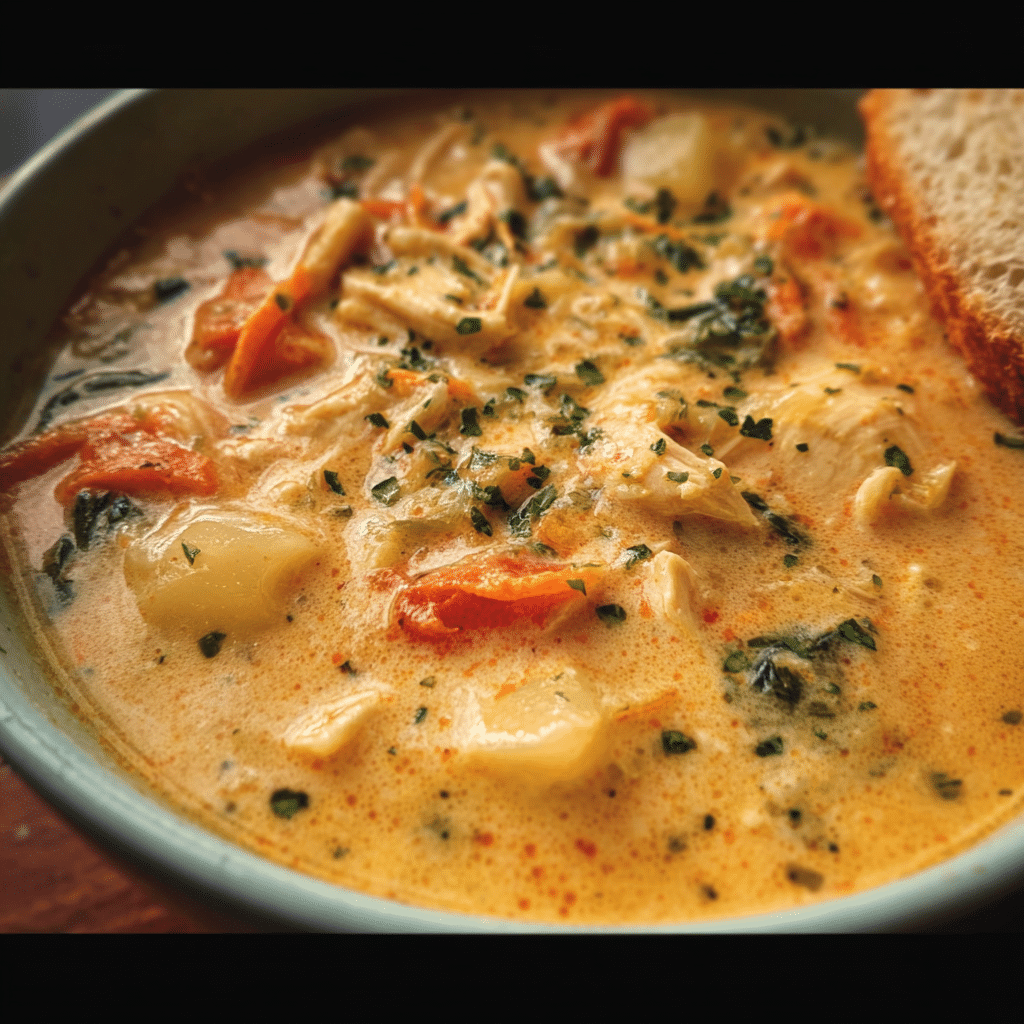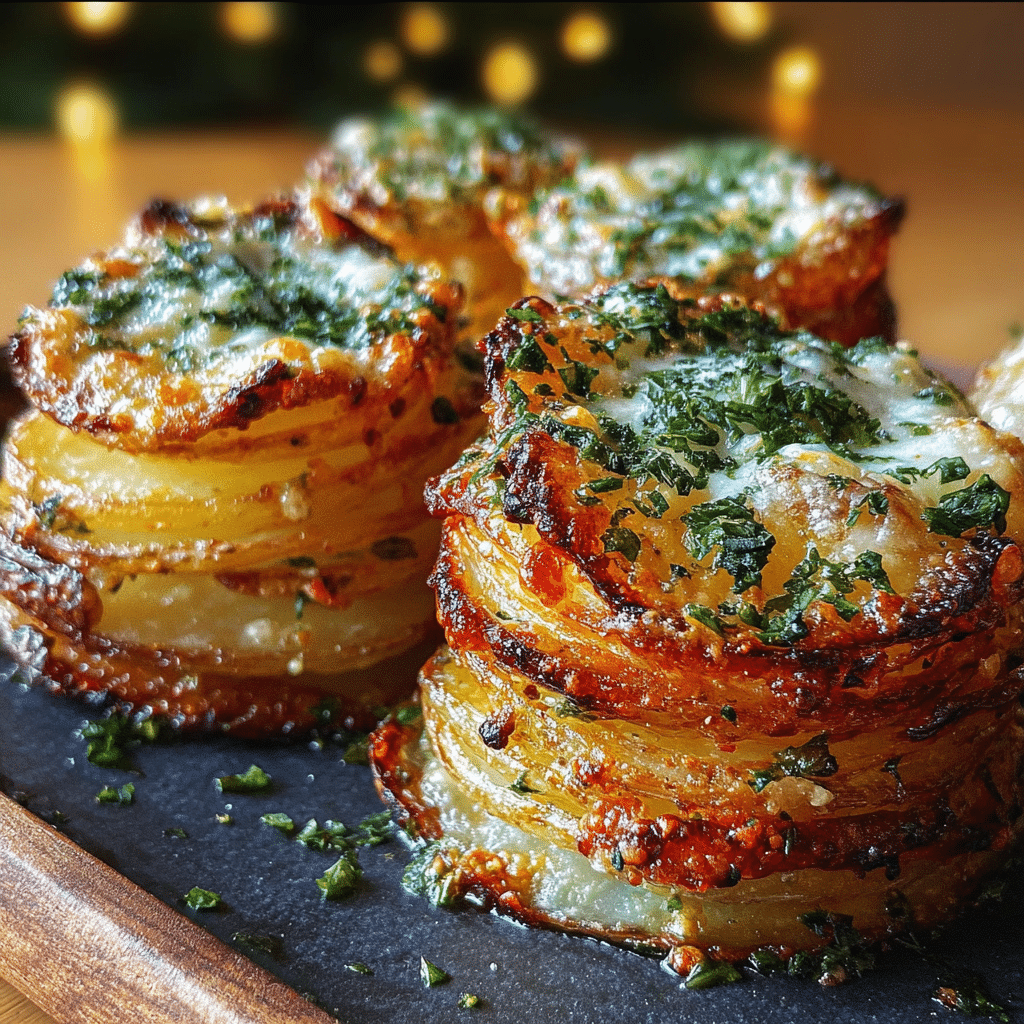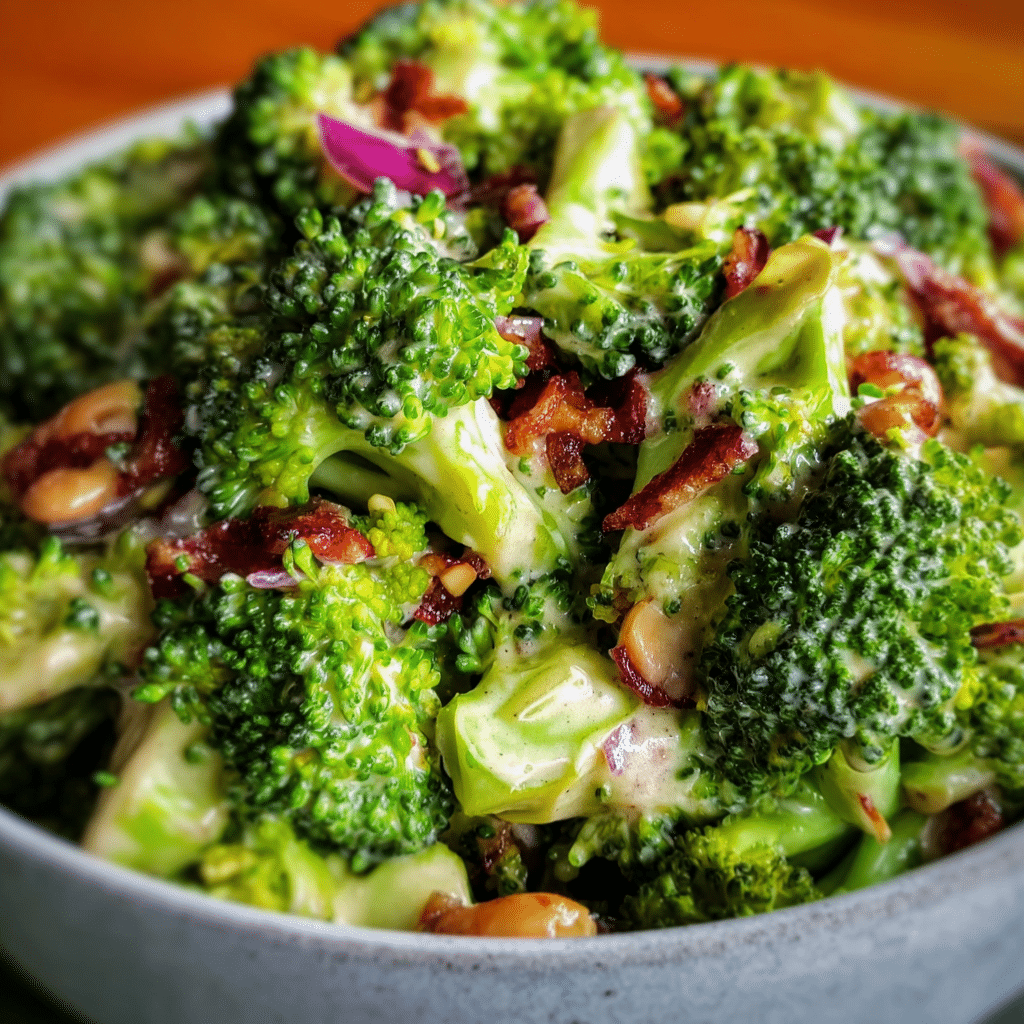Creamy chicken soup has a way of warming the soul, much like a cozy blanket on a chilly evening. I still remember the first time I made this delightful dish. It was a bustling weeknight, and I had just returned home from a long day at work, exhausted and craving comfort food. Flipping through my trusty old recipe book, I stumbled upon a creamy chicken soup recipe that promised to be simple yet satisfying. With a few essential ingredients and minimal prep time, I was convinced this would become a staple in my household.

As the chicken simmered in a pot, the aroma enveloped my kitchen, drawing my family in like moths to a flame. My kids, who usually rushed in and out of the kitchen, suddenly appeared, asking what smelled so good. It was in that moment I realized how powerful a bowl of creamy chicken soup could be—not just as a meal but as a way to bring loved ones together. Each spoonful was a blend of tender chicken, creamy broth, and an array of vegetables, creating a comforting experience that resonated with memories of family gatherings and winter holidays.
The Story Behind This Recipe
The history of creamy chicken soup is as rich as its texture. While the exact origins are somewhat murky, it is believed that soups featuring chicken and cream have been enjoyed for centuries across various cultures. In the United States, this dish gained popularity in the mid-20th century, especially with the rise of canned soups. However, my personal recipe is a blend of traditional techniques and modern convenience, making it perfect for busy families.
This dish is particularly special because it is versatile. You can modify it according to what you have on hand—whether it’s adding fresh herbs from your garden, leftover veggies from last night’s dinner, or even a splash of white wine for an elevated flavor. This adaptability ensures that no two bowls of creamy chicken soup are ever the same, making it an enjoyable adventure in the kitchen each time.
Why You’ll Love This Dish
For families juggling work, school, and extracurricular activities, creamy chicken soup is a lifesaver. It can be made in under an hour, offering a quick yet nutritious dinner solution. Plus, it freezes beautifully! I often make a double batch, allowing me to store half for those evenings when cooking feels like an insurmountable task. Simply reheat, and dinner is served!
This dish shines in every season, but there’s something especially comforting about enjoying it during the fall and winter months when the air turns crisp. It’s a perfect dish to serve on a rainy day, inviting warmth and comfort into your home. The creamy broth, combined with tender chicken and hearty vegetables, makes it feel like a hug in a bowl, ready to soothe any worries of the day.
The emotional connection I have with creamy chicken soup runs deep. It brings back memories of my grandmother, who would make a pot every Sunday, filling the house with a scent that felt like home. Even now, as I stir the pot and watch the steam swirl, I can almost hear her voice guiding me through the process. Cooking this soup has become a ritual for me, a way to honor her legacy while creating new memories with my own family.
In this guide, you will learn how to make your very own creamy chicken soup, exploring tips for customization, variations, and serving suggestions. Whether you’re a seasoned chef or a kitchen novice, you’ll find joy in crafting this heartwarming dish that promises to become a beloved staple in your home.
The Rich History and Cultural Significance of creamy chicken soup
The history of creamy chicken soup traces its roots back to ancient civilizations, where soups were often crafted as nourishing meals using available ingredients. While the exact origins may be debated, many cultures have their own variations that highlight the universal appeal of chicken as a primary protein source. From hearty stews in Europe to lighter broths in Asia, chicken has a long-standing reputation as a comfort food staple.
Origins and History
In Western cuisine, the idea of combining chicken with a creamy base can be traced back to the early 20th century when the popularity of cream-based soups surged. The 1950s saw the rise of convenience foods, and canned creamy chicken soups became a staple in many American households. However, the homemade versions of these soups have a much longer history, often made from scratch using leftover poultry and rich stock, thickened with cream or flour.
As time passed, recipes for creamy chicken soup evolved, with chefs and home cooks incorporating various herbs, spices, and vegetables to create unique flavors. From the classic combination of carrots and celery to more adventurous additions like mushrooms or spinach, the creativity in this dish has allowed it to endure through generations as a versatile and beloved meal.
Cultural Significance
Creamy chicken soup holds a special place in numerous cultures, often served during gatherings, celebrations, or as a remedy for illness. In many families, it is a dish passed down through generations, symbolizing warmth, comfort, and love. For example, in Jewish culture, chicken soup is often regarded as “Jewish penicillin,” believed to have healing properties for the sick and worn. It’s a dish that transcends mere sustenance; it’s a gesture of care and compassion.
Across the world, different regions have their own takes on creamy chicken soup. In France, the classic “potage” might be blended to create a silky texture, while in Southeast Asia, coconut milk is added for a unique twist. The adaptability of this dish highlights its cultural significance, as each variation tells a story of local ingredients and culinary traditions.
Nutritional Benefits
Aside from its cultural significance, creamy chicken soup also boasts various nutritional benefits that make it a wholesome choice for families. Chicken is a great source of lean protein, essential for muscle growth and repair, while vegetables like carrots and celery add vitamins and minerals that bolster overall health. The use of cream or milk not only enhances the flavor but also provides calcium and healthy fats, contributing to a balanced meal.
Moreover, homemade versions allow for control over the ingredients, making it easier to reduce sodium levels or incorporate whole foods. By adding whole grains like brown rice or quinoa, you can elevate the dish’s fiber content, making it even more filling and nutritious.
As you dive deeper into the world of creamy chicken soup, you’ll discover not just a recipe, but a dish rich in history and cultural significance. This guide will equip you with everything you need to create your own version, making it a comforting centerpiece in your family’s dining experience.
Essential Ingredients for Perfect creamy chicken soup
When it comes to crafting the perfect creamy chicken soup, the ingredients you choose are absolutely crucial. Each component brings its unique flavor and texture, contributing to that comforting bowl you crave, especially on a chilly day. Let’s dive into the essential ingredients that will transform your soup from ordinary to extraordinary.
Essential Ingredients
- Chicken: 2 cups of cooked, shredded chicken (preferably rotisserie for convenience)
- Chicken broth: 4 cups (homemade or store-bought, low-sodium is best)
- Heavy cream: 1 cup (for that luscious creaminess)
- Butter: 2 tablespoons (for sautéing vegetables)
- Onion: 1 medium onion, diced (adds depth of flavor)
- Garlic: 3 cloves, minced (for aromatic goodness)
- Carrots: 2 medium carrots, diced (for sweetness and color)
- Celery: 2 stalks, diced (adds crunch and flavor)
- Potatoes: 2 medium potatoes, diced (for heartiness)
- Fresh herbs: 1 tablespoon each of thyme and parsley (for freshness)
- Salt and pepper: to taste (essential for seasoning)
- Lemon juice: 1 tablespoon (to brighten the flavors)
Each ingredient plays a vital role in the overall profile of your creamy chicken soup. For instance, the chicken provides the main protein source, while the chicken broth serves as the flavorful base. Heavy cream is what elevates this dish, lending it that velvety texture that makes each spoonful a delight. The vegetables not only add nutrition but also contribute varying textures and flavors, making every bite interesting.
Print
How To Make Creamy Chicken Soup
Ingredients
- 2 tablespoons extra-virgin olive oil
- 1 small yellow onion, diced
- 1 medium carrot, diced
- 2 celery ribs, diced
- 3 garlic cloves, minced
- 4 tablespoons (½ stick) unsalted butter
- ¼ cup all-purpose flour
- 4 cups chicken stock
- 1 cup whole milk
- ½ teaspoon sea salt, plus more to taste
- ¼ teaspoon freshly cracked black pepper
- 1 tablespoon minced fresh dill, plus more for garnish
- 3 cups shredded cooked chicken
- ⅓ cup freshly grated Parmesan cheese, plus more for garnish
- 4 green onions, white and green parts, chopped, for garnish
Instructions
- Heat the olive oil in a large stockpot set over medium heat. Once the oil is glistening, add the onion, carrot, and celery and cook, stirring occasionally, until the vegetables are beginning to soften, about 8 to 10 minutes. Add the garlic and cook until fragrant, about 1 more minute.
- Add the butter to the pot. Once the butter is bubbling, sprinkle in the flour and stir until a thick paste forms. Cook for about 1 minute. Slowly add the chicken stock, stirring constantly, and bring to a boil over high heat. As soon as the soup is boiling, reduce the heat to a simmer and cook until the vegetables are tender, and the soup has thickened, about 5 more minutes.
- Add the milk, salt, pepper, dill, chicken, and Parmesan cheese, and stir to combine. Simmer until the chicken is warmed through and the Parmesan is fully incorporated, about 3 more minutes. Taste and adjust seasoning as needed.
- Ladle the soup into bowls and top with green onions, more dill, and extra Parmesan, if desired.
Shopping Tips
When shopping for ingredients, quality is key. Opt for organic chicken if possible, as it tends to have a better flavor and is free from harmful additives. If you’re purchasing broth, look for low-sodium options to control the saltiness of your soup. Fresh vegetables are a must; when selecting onions, choose ones that feel firm with shiny, dry skins. For herbs, fresh is always preferable over dried, ensuring maximum flavor.
Seasonal availability can also influence your choices. For example, fresh herbs are usually at their peak in spring and summer, while root vegetables like carrots and potatoes are typically available year-round. Sourcing from local farmers’ markets can yield fresher and more flavorful produce, and it’s a great way to support local agriculture.
Substitutions and Alternatives
Dietary restrictions shouldn’t prevent you from enjoying a bowl of creamy chicken soup. If you’re looking for a gluten-free option, ensure your broth is gluten-free and consider using cornstarch as a thickening agent if needed. For those who are dairy intolerant, coconut milk or a nut-based cream can serve as excellent substitutes for heavy cream, although they will impart their unique flavors.
Vegetarians can easily adapt this recipe by using vegetable broth and swapping chicken for hearty ingredients like chickpeas or mushrooms. If you want to make it vegan, simply replace the cream with a plant-based alternative and omit any animal products. Budget-minded cooks can look for sales on vegetables and buy in bulk, especially when it comes to staples like potatoes and carrots. These ingredients are not only versatile but also inexpensive, making them a great choice for a hearty soup.
Finally, store your ingredients properly to maximize freshness. Keep vegetables in the crisper drawer of your refrigerator and ensure that your chicken is stored in a sealed container. Cooked chicken can be frozen for later use, making it a convenient option for meal prep. With these tips in mind, you’ll be well on your way to creating a delicious creamy chicken soup that warms both the heart and the soul.
Detailed Step-by-Step creamy chicken soup Cooking Instructions
Now that you have all your ingredients ready, it’s time to roll up your sleeves and get cooking! Making creamy chicken soup is a straightforward process that yields delicious results. With just a few steps, you can create a comforting dish that could easily become a new family favorite. Let’s break down the process step-by-step.
Preparation Steps
- Gather your ingredients: Before you start cooking, ensure you have all your ingredients measured and ready to go. This process, known as mise en place, makes cooking smoother and more enjoyable.
- Prep the vegetables: Dice the onion, carrots, celery, and potatoes. The key is to make them uniform in size so they cook evenly. Mince the garlic and set it aside.
- Shred the chicken: If you haven’t done so already, shred your cooked chicken into bite-sized pieces. Using rotisserie chicken is a time-saver and adds a depth of flavor.
Cooking Process
- Sauté the aromatics: In a large pot, melt the butter over medium heat. Once melted, add the diced onions, carrots, and celery. Sauté for about 5-7 minutes until the vegetables soften and the onions become translucent.
- Add the garlic: Stir in the minced garlic and cook for an additional 1-2 minutes until fragrant. Be careful not to let it brown, as burnt garlic can impart a bitter flavor.
- Incorporate the broth: Pour in the chicken broth, and bring the mixture to a simmer. This will form the base of your creamy chicken soup.
- Add the potatoes: Once the broth is simmering, add the diced potatoes. Cook for about 10-15 minutes, or until the potatoes are tender.
- Mix in the chicken: Stir in the shredded chicken and fresh herbs. Allow the soup to simmer for another 5 minutes to heat through and meld the flavors.
- Make it creamy: Reduce the heat to low and stir in the heavy cream. This step is crucial for achieving that decadent texture that makes creamy chicken soup so special. Be sure not to let it boil once the cream is added.
- Season to taste: Add salt, pepper, and lemon juice to taste. The lemon juice will brighten the flavors and balance the richness of the cream. Taste and adjust the seasoning as necessary.
Final Assembly
- Serve hot: Ladle the soup into bowls and garnish with additional fresh herbs if desired. This not only adds a pop of color but also enhances the freshness of the dish.
- Storage tips: Leftover soup can be stored in an airtight container in the refrigerator for up to 3 days. If you wish to freeze it, consider doing so before adding the cream, as dairy can change texture when frozen. Reheat gently on the stove, adding a splash of broth if necessary to loosen it up.
Common mistakes to avoid include rushing the sautéing process or skipping the seasoning steps. The depth of flavor in your creamy chicken soup comes from those initial stages, so take your time. Additionally, keeping an eye on the heat is essential; you want to simmer but not boil once the cream is added to prevent curdling.
Chef’s secrets include using fresh herbs right at the end for maximum flavor, and not skimping on the quality of your broth. A good broth can make all the difference in a soup, enhancing the overall taste and mouthfeel. The entire cooking process should take about 30 minutes, making it a quick yet deeply satisfying meal.
With these detailed instructions, you’re well-equipped to whip up a delightful bowl of creamy chicken soup. Enjoy the process, savor the aromas, and let the warmth of this dish fill your home and your heart!
Professional Tips and Techniques for creamy chicken soup
When it comes to making a delicious bowl of creamy chicken soup, a few professional tips and techniques can elevate your dish from ordinary to extraordinary. This beloved comfort food can warm your soul on a chilly day, and with the right methods, you can create a creamy chicken soup that’s bursting with flavor and texture.
Professional Techniques
To start, let’s talk about the basics. A great creamy chicken soup begins with a flavorful base. Sautéing your vegetables—like onions, carrots, and celery—first in a good quality butter or olive oil is essential. The aromatic qualities released during this process create a rich foundation. I often reminisce about my grandmother’s kitchen, where the smell of sautéing vegetables would waft through the air, inviting everyone to gather around.
Another crucial technique is to use a quality stock. Homemade chicken stock is always preferable if you have the time, but if not, choose a low-sodium store-bought option. This will allow you to control the salt levels in your creamy chicken soup. When simmering the soup, add the chicken to the pot raw. This might seem counterintuitive, but cooking the chicken directly in the soup helps to infuse the broth with flavors, resulting in a richer, creamier texture.
If you’re looking to achieve that perfect creamy consistency without the use of heavy cream, try incorporating some mashed potatoes or a roux. A roux, made from equal parts flour and fat, can be whisked into the broth and will thicken the soup beautifully while adding a velvety texture. This technique has been a game-changer for me, especially when I want a lighter version of creamy chicken soup without sacrificing that delightful creaminess.
Troubleshooting Guide
Even with the best intentions, sometimes things don’t go as planned in the kitchen. If your creamy chicken soup turns out too thin, don’t fret! You can thicken it with a cornstarch slurry (mixing cornstarch with cold water) or by letting it simmer uncovered to reduce the liquid. On the other hand, if you find that your soup is too thick, simply add more stock or water until you reach the desired consistency.
Another common issue is seasoning. Remember, seasoning is a layered process. Taste your broth at various stages of cooking. If it’s lacking flavor, consider adding a splash of white wine or a squeeze of lemon juice to brighten it up. I’ve learned through experience that a little acid can make all the difference in a dish, cutting through the richness of the cream and chicken.

Presentation Tips
Once your creamy chicken soup is perfectly cooked, presentation is key! Serve it in beautiful bowls, and consider garnishing with fresh herbs like parsley or thyme for a pop of color. Drizzling a little extra cream or a swirl of olive oil on top right before serving can also add a beautiful finishing touch. I love to serve my soup with crusty bread on the side, perfect for dipping and soaking up that creamy goodness.
Furthermore, wine pairings can enhance your dining experience. A Chardonnay, with its buttery notes, complements the richness of creamy chicken soup beautifully. For a non-alcoholic option, consider serving a sparkling water with a slice of lemon, which can cleanse the palate between bites.
As for meal prep strategies, creamy chicken soup is a fantastic make-ahead option. You can prepare it up to three days in advance and store it in the refrigerator. Just remember that the soup may thicken as it cools, so you might need to add a bit of stock when reheating. If you plan to freeze it, consider leaving out the cream until you’re ready to serve. This will help maintain the texture and flavor.
Finally, if you’re cooking for a crowd or want to scale the recipe, it’s quite straightforward. Just multiply the ingredients while keeping an eye on the cooking times. Large batches can be made in a stock pot or even a slow cooker for convenience. The slow cooker method allows the flavors to meld beautifully, making it a favorite for busy weeknights.
Creative Variations and Adaptations of creamy chicken soup
Creamy chicken soup is incredibly versatile, allowing for a myriad of creative variations and adaptations that can cater to different tastes and dietary needs. This adaptability is one of the reasons why this dish has become a staple in many households, including mine. Let’s explore some exciting ways to put a twist on this comforting classic!
Seasonal Variations
As the seasons change, so do the ingredients available to us. In the fall, consider adding pumpkin or sweet potatoes for a touch of sweetness and warmth. A creamy chicken soup with butternut squash can be an extraordinary way to celebrate autumn. As spring rolls around, fresh peas and asparagus can brighten your soup while adding a vibrant green color. This not only enhances the presentation but also the flavor profile, making your creamy chicken soup truly seasonal.
In summer, think about incorporating corn and zucchini. These vegetables add a delightful crunch and sweetness that can lighten up the dish. I once made a corn and zucchini version for a summer picnic, and it was a hit! The freshness of the ingredients complemented the creaminess, making it the perfect dish to enjoy outdoors.
Dietary Adaptations
In today’s world, dietary restrictions are common, and creamy chicken soup can easily be adapted for various lifestyles. For a healthier, lower-carb version, you can use cauliflower instead of potatoes to thicken your soup, achieving a similar creaminess without the extra carbs. If you are looking for a vegan option, consider substituting chicken with chickpeas or tofu and using coconut milk or cashew cream for that rich, creamy texture.
Gluten-free eaters can easily modify this recipe by using gluten-free flour for the roux or opting for cornstarch to thicken the soup. It’s fascinating how simple ingredient swaps can make this dish accessible to everyone while still retaining the comforting essence of traditional creamy chicken soup.
Creative Twists
For those who love to experiment, there are endless possibilities to infuse new flavors into your creamy chicken soup. Adding spices such as curry powder or smoked paprika can give your soup a unique twist. I remember a time when I added a pinch of curry powder to my broth, and the flavor was unexpected yet delightful, transporting me to a different culinary world.
International fusion variations can also be a fun way to shake things up. A Thai-inspired creamy chicken soup with coconut milk, lemongrass, and ginger can turn your kitchen into a tropical getaway. Alternatively, a Mexican version with poblano peppers, corn, and lime can add a zesty kick that brightens the palate.
For those who find themselves with leftovers, consider transforming your creamy chicken soup into a delicious pasta sauce. Simply reduce the soup on the stove to thicken it and toss it with cooked pasta for a quick and satisfying meal. It’s a clever way to avoid food waste while also enjoying a different flavor experience!
In conclusion, creamy chicken soup is not just a one-size-fits-all recipe. With these variations and adaptations, you can create a dish that reflects your tastes, honors the seasons, and accommodates dietary needs. Whether you’re sticking to the classic version or trying something new, each bowl of creamy chicken soup tells a story and brings people together—just as it has done in my family for generations.
Storage, Reheating, and Meal Prep for creamy chicken soup
When it comes to creamy chicken soup, one of the best aspects is its versatility, not just in terms of ingredients, but also in its storage capabilities. You might find yourself making a big batch of this comforting dish on a chilly evening, anticipating those cozy nights spent curled up on the couch. But what do you do with the leftovers? Or how can you prepare it ahead of time for busy weekdays? Let’s dive into the world of storage, reheating, and meal prep for creamy chicken soup.
Short-term Storage
For those nights when you whip up a pot of creamy chicken soup, you might want to save some for later enjoyment. The best way to store your leftover soup is in the refrigerator. Allow the soup to cool completely before transferring it to airtight containers. Glass containers are an excellent choice because they don’t absorb odors and are microwave safe. You can also use BPA-free plastic containers, but make sure they are labeled as microwave safe.
When storing your creamy chicken soup in the refrigerator, aim to consume it within 3 to 4 days for the best taste and safety. If you know you won’t finish it in that time frame, consider freezing it instead. Remember to label your containers with the date, so you can keep track of how long it’s been stored.
Freezing and Long-term Storage
Freezing is an excellent option if you want to enjoy creamy chicken soup weeks or even months later. However, there are a few key guidelines to follow to ensure the soup maintains its creamy texture and flavor upon thawing. First, consider the ingredients you’ve used. If your soup contains potatoes or pasta, be aware that these can become mushy after freezing. It’s often best to freeze the soup without these ingredients and add them fresh when reheating.
To freeze your creamy chicken soup, allow it to cool thoroughly, then portion it into freezer-safe containers or heavy-duty freezer bags. If using bags, lay them flat in the freezer to save space and for quicker thawing. Remove as much air as possible from the bags to prevent freezer burn. Label each bag with the date and contents for easy identification later on. Creamy chicken soup can be frozen for up to 3 months without significant loss in quality.
Reheating Best Practices
Now that you’ve stored your creamy chicken soup, the next step is reheating it without sacrificing its delightful creamy texture. The best method for reheating is on the stove over medium heat. Pour the soup into a saucepan and stir occasionally, allowing it to heat gently. If the soup appears too thick, you can add a splash of chicken broth or milk to help restore its creamy consistency. This method helps maintain the flavor and texture far better than microwaving, which can create uneven heating.
If you choose to microwave your creamy chicken soup, do so in short intervals of about 1 minute, stirring in between to ensure even heating. Be cautious, as microwaving can sometimes lead to splattering or overheating, so it’s best to use a microwave-safe cover. Additionally, always check that the soup is heated through to at least 165°F (74°C) before serving.
Meal prep enthusiasts will love creamy chicken soup for its batch cooking potential. You can prepare a large pot of soup on the weekend and store portions for easy lunches or dinners throughout the week. Just remember to follow the storage guidelines mentioned earlier, and consider portioning the soup into single-serving containers for convenient grab-and-go meals. This strategy not only saves time but also helps in maintaining portion control.
Food safety is paramount when storing and reheating creamy chicken soup. Always ensure that your soup is cooled and stored promptly after cooking. If you’re reheating soup that has been thawed, make sure to consume it within 24 hours for optimal safety. Additionally, never refreeze soup that has already been thawed, as this can lead to a decline in quality and safety.
Ultimately, with the right storage and reheating techniques, you can enjoy creamy chicken soup long after it’s left the stovetop. Whether you savor it fresh or revel in the convenience of leftovers, this soup remains a staple in many homes for a reason. So go ahead and make that big batch, knowing that you have a plan for storage and reheating!
Nutritional Benefits and Health Information
As a comforting staple in many households, creamy chicken soup not only warms the heart but also provides a range of nutritional benefits. Understanding the nutritional profile of creamy chicken soup can help you appreciate its value beyond just taste. Let’s explore the various ingredients that make up this beloved dish and how they contribute to your health.

Nutritional Profile
The nutritional content of creamy chicken soup can vary based on the ingredients used, but it typically includes chicken, vegetables, broth, cream or milk, and seasonings. On average, a one-cup serving of creamy chicken soup contains around 250-300 calories, depending largely on the amount of cream or fat used. Here’s a breakdown of the main components:
- Protein: Chicken is a fantastic source of lean protein, essential for muscle repair and growth.
- Carbohydrates: If you include vegetables like carrots, potatoes, or corn, these will contribute healthy carbohydrates and fiber.
- Fats: The cream or milk adds richness but also comes with saturated fats; this is where moderation is key.
- Vitamins and Minerals: Ingredients like celery and carrots provide essential vitamins such as vitamin A, vitamin K, and folate.
For those mindful of their dietary intake, creamy chicken soup can be adjusted to fit various nutritional needs. You can swap heavy cream for milk or a non-dairy alternative to reduce calories and fat, or use whole grain or gluten-free pasta instead of regular pasta for additional fiber.
Health Benefits
The health benefits of creamy chicken soup extend beyond its satisfying taste. Chicken is a rich source of niacin, vitamin B6, and phosphorus, which are important for energy metabolism and maintaining strong bones. The vegetables add fiber, which aids in digestion and can help maintain a healthy weight.
Additionally, a warm bowl of creamy chicken soup can provide comfort during cold seasons or when you’re feeling under the weather. The warmth of the soup can help soothe sore throats, and the combination of nutrients supports the immune system. In fact, chicken soup has been celebrated for generations as a natural remedy for colds and flu, providing hydration along with nourishment.
Dietary Considerations
While creamy chicken soup is generally a wholesome choice, there are some dietary considerations to keep in mind. For those with lactose intolerance or dairy allergies, using lactose-free milk or coconut milk can provide a creamy texture without discomfort. Additionally, if you’re following a low-sodium diet, opt for low-sodium chicken broth and limit added salt when preparing your soup.
Vegetarians or vegans may also enjoy a version of creamy chicken soup that substitutes chicken with plant-based proteins like chickpeas or tofu, while using vegetable broth instead of chicken broth. This allows everyone to partake in the deliciousness of creamy chicken soup without compromising their dietary preferences.
In terms of calorie content and macronutrient distribution, a mindful approach is key. For those tracking caloric intake, keeping an eye on portion sizes and ingredients can help maintain a balanced diet. To further enhance the nutritional profile, consider adding leafy greens such as spinach or kale for added vitamins and minerals.
When comparing creamy chicken soup to similar dishes, such as chowders or bisques, creamy chicken soup often comes out as a lighter option, especially when prepared with fresh ingredients and less cream. Chowders tend to be thicker and richer, while creamy chicken soup strikes a balance between comfort and nourishment, making it a go-to for many families.
In conclusion, creamy chicken soup is not just a delightful dish but also a nutritional powerhouse when prepared thoughtfully. Its versatility allows for numerous variations that cater to diverse dietary needs, making it a beloved comfort food that can nourish both body and soul.
Frequently Asked Questions About Creamy Chicken Soup
Best creamy chicken soup recipe
The best creamy chicken soup recipe often balances rich flavors and textures while being simple enough to prepare on a busy day. Start by sautéing onions, garlic, and carrots in butter to develop a robust base. Use quality chicken, ideally boneless thighs, for tenderness, and add a mixture of herbs like thyme and parsley for freshness. Incorporate heavy cream or a roux made from flour and butter for that velvety texture. Don’t forget to season with salt and pepper to taste, and consider adding a splash of lemon juice for brightness before serving.
Simple creamy chicken soup recipe
A simple creamy chicken soup recipe can be made with minimal ingredients and time, perfect for a weeknight meal. Begin by cooking diced chicken in a pot until browned, then add chopped onions, celery, and carrots, cooking until softened. Pour in chicken broth and let it simmer before adding heavy cream for richness. To thicken the soup, you can either use a cornstarch slurry or blend a portion of the soup and mix it back in. Adjust flavors with salt, pepper, and your favorite herbs, making it a customizable dish.
Creamy chicken soup packet
Creamy chicken soup packets are a convenient option for those looking to save time without sacrificing flavor. These packets usually contain dehydrated ingredients and seasonings, making it easy to prepare a soup by simply adding water or broth. To enhance the flavor, consider adding fresh vegetables, cooked chicken, or herbs to the pot while the soup simmers. For a creamier texture, you can stir in some heavy cream or a dollop of sour cream just before serving. Always check the salt content in the packet to avoid over-seasoning your dish.
Creamy chicken soup with potatoes
For a hearty version of creamy chicken soup, adding potatoes can provide both flavor and substance. Start by dicing potatoes and adding them to the pot along with your sautéed vegetables for a creamy texture. Using Yukon Gold or red potatoes works best as they hold their shape well during cooking. Allow the potatoes to cook until tender before adding the chicken and cream, making sure to simmer until everything is well combined. Consider using chicken stock infused with herbs to deepen the flavor and balance the creaminess of the soup.
Conclusion: Mastering the Perfect creamy chicken soup
Creating the perfect creamy chicken soup is more than just following a recipe—it’s about understanding the techniques, ingredients, and cultural significance behind this beloved dish. Throughout this comprehensive guide, we’ve explored everything from the historical origins to modern variations, ensuring you have all the knowledge needed to make this recipe your own.
Whether you’re a beginner cook or an experienced chef, the techniques and tips we’ve shared will help you create a creamy chicken soup that’s not only delicious but also meaningful. Remember that cooking is a journey of discovery, and each time you make this dish, you’ll learn something new.
We encourage you to experiment with the variations we’ve discussed, adapt the recipe to your dietary needs, and most importantly, share it with the people you love. Food has the incredible power to bring people together, and Creamy Chicken Soup is the perfect dish to create lasting memories around your dinner table.





